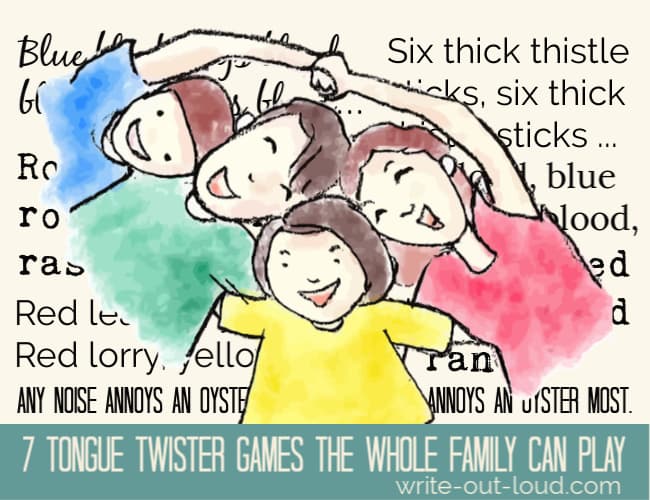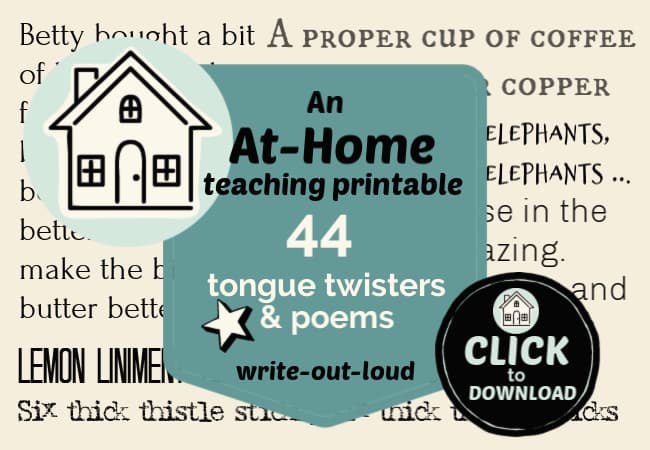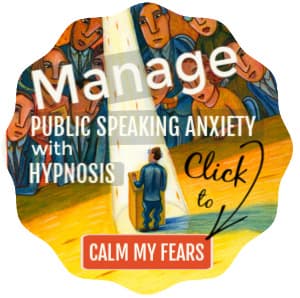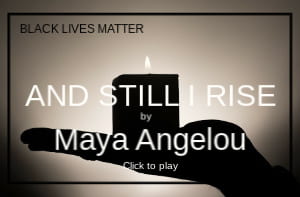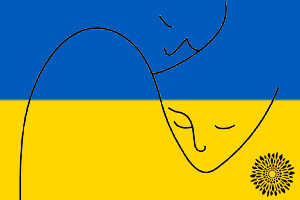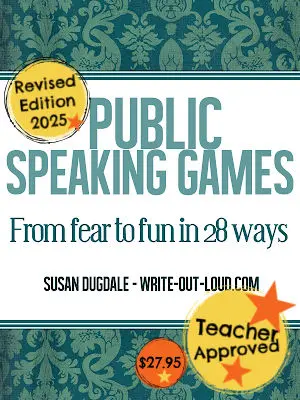- HOME ›
- Activities and games ›
- Tongue twister games
Tongue twister games for crisp articulation
7 fun speech games the whole family can play
By: Susan Dugdale
Tongue twisters – Oh, the tangling, tantalizing fun to be had teasing tongues with tricky to say trivialities!
These seven speech games focus on developing fluency, clear, crisp articulation and pronunciation – all equally necessary for good oral communication. And most importantly, they are fun.
The whole family can play them, even the little ones from about three or four years old.
They're perfect for regular school classes or for in-home teaching. For even more giggly silliness, video them. Get a challenge going with your students, friends or family!
Download a tongue twister printable
To make it easier to get started, along with the instructions for each game, I've included a printable of 44 tongue twisters and poems. You'll find that at the bottom of the page.
Let the competition begun! Who has the fastest, clearest speech?
1. Tongue twister battles (2 variations)
Variation 1: Timed races
You can play races in pairs or with three or more. You'll need a stop watch or timer and a tongue twister. Use one of your own or one from the resource provided.
Eg. A box of biscuits, a batch of mixed biscuits.
Nominate which person will begin.
Start the stopwatch for 1 minute.
The person speaking repeats the twister without mistakes as many times as they can inside the minute.
Keep count of each clean, clear repetition. Bungled iterations are not included.
When the minute is up call “Stop”, and the roles are changed over. The stopwatch is set for another minute. Now another person has a turn at saying the twister, and the listeners count.
The winner is the person who has the highest number of clear repetitions inside a minute.
Variation two: Go until you flub, blunder and bungle
Gather your players - two, three or more
Decide how many rounds you are going to have. One? Two? Three?
Choose your tongue twisters, one for each round.
For example:
- Round one - A proper cup of coffee from a proper copper coffee pot.
- Round two - Three free throws, three free throws...
- Round three - Sister Susie sat on the seashore sewing shirts for sailors.
Nominate a person to begin.
They repeat the twister until they make an error.
Then the next person's turn. And so on until the first round is completed.
Keep a tally of each player's score in every round.
The winner is the person with the highest number of clear repetitions over all rounds.
3. Tongue twister rounds
If you thought playing races was a doddle (easy), step it up with rounds.
These will really make you work. They're great for focus, as well as those other benefits: fluency and articulation.
For rounds you'll need two or more players. (If you have more make them into equal groups.)
Start with one tongue twister to get into the swing of it, and then move on to using two once you have it mastered.
Choose one of the longer tongue twisters. (The shorter ones like 'Red lorry, yellow lorry' will not work.) For instance, try: 'Three gray geese in the green grass grazing. Gray were the geese and green was the grass.'
Group 1 begins and says the twister through once.
On the 2nd time through when they get to the end of the first sentence ('Three gray geese in the green grass grazing.'), bring in the second group.
Meanwhile group 1 continues.
Be prepared for giggling chaos. And keep going!
Now make it even trickier. Use two tongue twisters!
Once you have it down, try introducing a second tongue twister.
So you'll have one group saying 'Three gray geese' etc, while the second group is saying, for instance:
'Whether the weather be cold
Or whether the weather be hot
Whatever the weather we'll weather the weather
Whether we like it or not.'
4. Psst - tongue twister whispers
You'll need at least four or more to play this game well.
The players form a line. The first chooses a tongue twister to whisper to the second, who then whispers what they heard to the third, and so on down the line.
The person at the end of the line says what they heard. Is the original tongue twister garbled? Has it morphed into a mangled mush? That's highly likely!
Now the person at the end of the line comes to the front. They choose a tongue twister to pass on. Repeat until everyone has had a turn.
5. Walk it, hop it, stamp it , clap it, tongue twisters
Get a rhythm going. These twisters are fun to march and stamp to, hop to, and clap to.
Indoors? Get your team going around the building: down the hall, through the lounge, round the kitchen, out onto the deck and back again. If you're able to go outside set them off around the yard.
Choose a leader who will then choose a twister, establish the beat to move to and the accompanying action: clapping, stomping, clicking ... At the end of a couple of minutes call change. The leader drops to the back of line.
The new leader chooses another twister, sets up a rhythm and the moves to go with it. When change is called they too drop to the back.
Keep going until you've given everyone an opportunity to lead.
6. Crying tongue twisters, laughing tongue twisters
Let's add an emotion or a feeling to the way these tongue twisters are said. What will that do to their delivery? Will they be said more loudly? Faster? Softly?
To set this up you'll need a collection of easily recognized feeling states - ones you could expect all the people in your family/group to understand from youngest up.
Happy, angry, sad, shy, surprised, bored, loving, disgusted, worried ...
The person starting chooses a tongue twister and a feeling state. The group repeats the twister 3 or so times in that way.
Then the next person chooses a new feeling state. Now the same twister is said in that way.
And so on, using the same twister but changing the emotional state all the way through the group until everybody has had a turn.
If you'd like more on how emotion and character changes vocal delivery check out this page: characterization techniques for storytelling in speeches
7. Conducted tongue twisters
Now we're going turn these tongue twisters into a performance piece.
How will they be said fast? Slow? Quietly? Loudly? Sweetly? Sadly? In a chorus? As a solo?
The conductor will decide.
Establish what the signal is for louder, softer, a whisper, slower, faster, stop, go, solo, all ...
Then choose a conductor who chooses a tongue twister for the group. The conductor stands in front of the group using the prearranged signals to shape the delivery.
Give each conductor about 3 minutes or so, and then swap the role. Stop when everybody has a turn.
With practice you'll get some extraordinary presentation pieces. They'll be great for your next family concert, or for videoing to share with far away friends and family.
Try Dr Seuss's 'About Socks' poem that's included in the pdf. It is wonderful fun!
Now get the printable to go with the games!
I hope you have fun with these.
If you're teaching, they're a great addition to any language arts program you might be putting together.
For more (some with freebie downloadable printables) check this page: speech/public speaking activities

About the Author: Susan Dugdale, founder of write-out-loud.com, is a qualified teacher of English and drama with over 40 years of experience. Drawing on her professional expertise and her personal journey from shyness to confidence, Susan creates practical, real-world resources to help people find their voice and speak with power.
